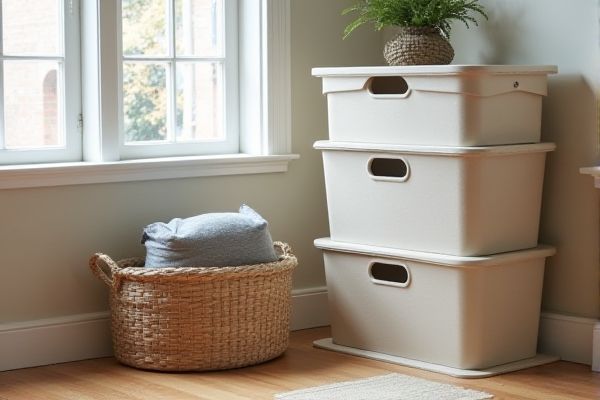
Stackable storage bins maximize vertical space by securely piling on top of each other, making them ideal for organizing areas with limited floor space. Nesting storage bins save room when not in use by fitting inside one another, offering convenience for seasonal storage--explore the article to discover which option suits your storage needs best.
Table of Comparison
| Feature | Stackable Storage Bins | Nesting Storage Bins |
|---|---|---|
| Design | Bins designed to stack vertically for space optimization | Bins designed to fit inside each other when empty |
| Space Efficiency (In Use) | Maximizes vertical storage space | Less vertical stacking capability, often single layer |
| Space Efficiency (When Empty) | Maintain full bin size, occupy full footprint | Nest inside each other, reducing storage volume by up to 70% |
| Durability | Typically sturdy to bear weight of stacked bins | Durable but built smaller for nesting convenience |
| Accessibility | Easy to stack and retrieve individual bins | Requires un-nesting when accessed, less immediate usability |
| Typical Use Cases | Warehouses, retail displays, and organized storage | Seasonal storage, transport efficiency, and space-saving when empty |
| Material | Heavy-duty plastic or metal for load-bearing | Light to medium-duty plastic, focuses on nesting shape |
| Cost | Generally higher due to reinforced design | Often lower due to simpler structure |
Introduction to Stackable and Nesting Storage Bins
Stackable storage bins maximize vertical space by securely piling bins on top of each other, making them ideal for organizing areas with limited floor space. Nesting storage bins save room when empty by fitting one inside another, providing efficient storage and easy portability. Understanding your storage needs helps you decide whether stackable or nesting bins best optimize your space and accessibility.
What Are Stackable Storage Bins?
Stackable storage bins are designed with flat lids and reinforced edges, allowing multiple units to be securely stacked on top of each other to optimize vertical space. These bins provide easy access to contents without unstacking, making them ideal for organized storage in garages, warehouses, and offices. Made from durable materials like polypropylene or heavy-duty plastic, stackable bins enhance spatial efficiency and improve inventory management.
What Are Nesting Storage Bins?
Nesting storage bins are designed to fit inside one another when empty, maximizing storage efficiency and saving space. Unlike stackable storage bins, which are built to securely stack on top of each other when filled, nesting bins prioritize compact storage by collapsing into a smaller footprint. Your choice depends on whether you need easy access while stacked or maximum space-saving when not in use.
Key Features of Stackable Storage Bins
Stackable storage bins feature sturdy, reinforced edges and uniform sizes that enable secure, space-saving vertical stacking to maximize storage efficiency. Their interlocking lids prevent shifting, making them ideal for organizing items in garages, warehouses, or homes. You benefit from easy access and flexibility since stackable bins maintain their shape and can be used individually without nesting.
Key Features of Nesting Storage Bins
Nesting storage bins are designed with tapered sides that allow bins to fit one inside another, maximizing vertical space when not in use and reducing storage footprint. They feature built-in hand grips for easy lifting and stacking, offering stability and convenience in both storage and transport. These bins are often made from durable polypropylene, ensuring resistance to impact and moisture while providing clear visibility of contents for efficient organization.
Space Efficiency Comparison
Stackable storage bins maximize vertical space by securely piling bins on top of each other, making them ideal for compact areas or limited floor space. Nesting storage bins save space when not in use by fitting one bin inside another, reducing storage volume significantly during off-season or bulk storage. Your choice depends on whether you prioritize ongoing organization or minimizing space when bins are empty.
Durability and Material Differences
Stackable storage bins are typically made from heavy-duty plastic or metal, offering enhanced durability and the ability to support heavier loads without deformation. Nesting storage bins, often constructed from lighter plastic materials, prioritize space-saving by fitting inside one another but may sacrifice some strength and resistance to wear. The choice between these bins depends on the need for robust, long-lasting storage in high-use environments versus efficient, compact storage when space is limited.
Use Cases: When to Choose Stackable vs Nesting
Stackable storage bins are ideal for maximizing vertical space in environments like warehouses, offices, or garages where items need to be easily accessible and organized in layers. Nesting storage bins work best when you require space-saving solutions for storing empty bins, such as in retail backrooms or during transport, allowing them to collapse inside one another when not in use. Choose stackable bins for frequent access and separation of contents, while nesting bins suit scenarios focused on compact storage efficiency when bins are empty.
Cost Considerations and Value
Stackable storage bins often provide better long-term value due to their ability to maximize vertical space, reducing overall storage footprint and potentially lowering facility rental costs. Nesting storage bins typically offer initial cost savings by minimizing shipping and storage volume when empty, but may require more floor space when in use, impacting operational efficiency. Evaluating total cost of ownership reveals stackable bins can deliver higher ROI in environments where space optimization and accessibility are priorities.
Which Storage Bin Type Is Right for You?
Stackable storage bins maximize vertical space by securely locking on top of each other, ideal for environments with limited floor area needing efficient organization. Nesting storage bins save space when not in use by fitting inside each other, making them perfect for variable storage needs and easy transport. Choosing between them depends on your primary requirement: stable, compact storage versus flexible, space-saving storage when empty.
 homyna.com
homyna.com